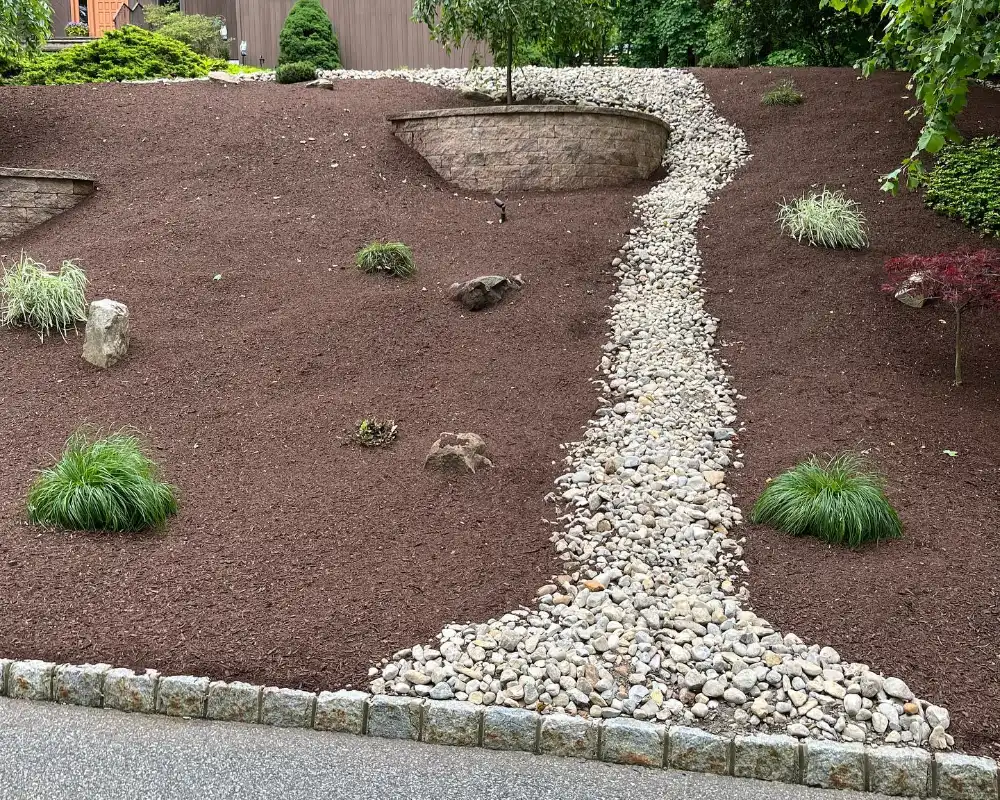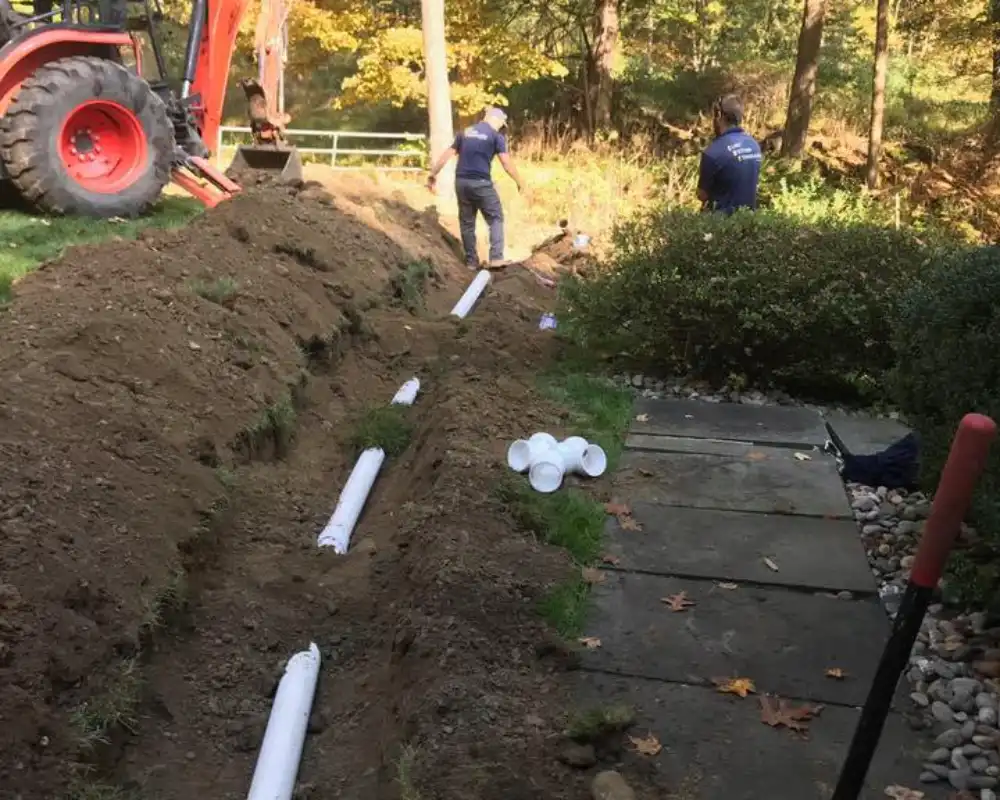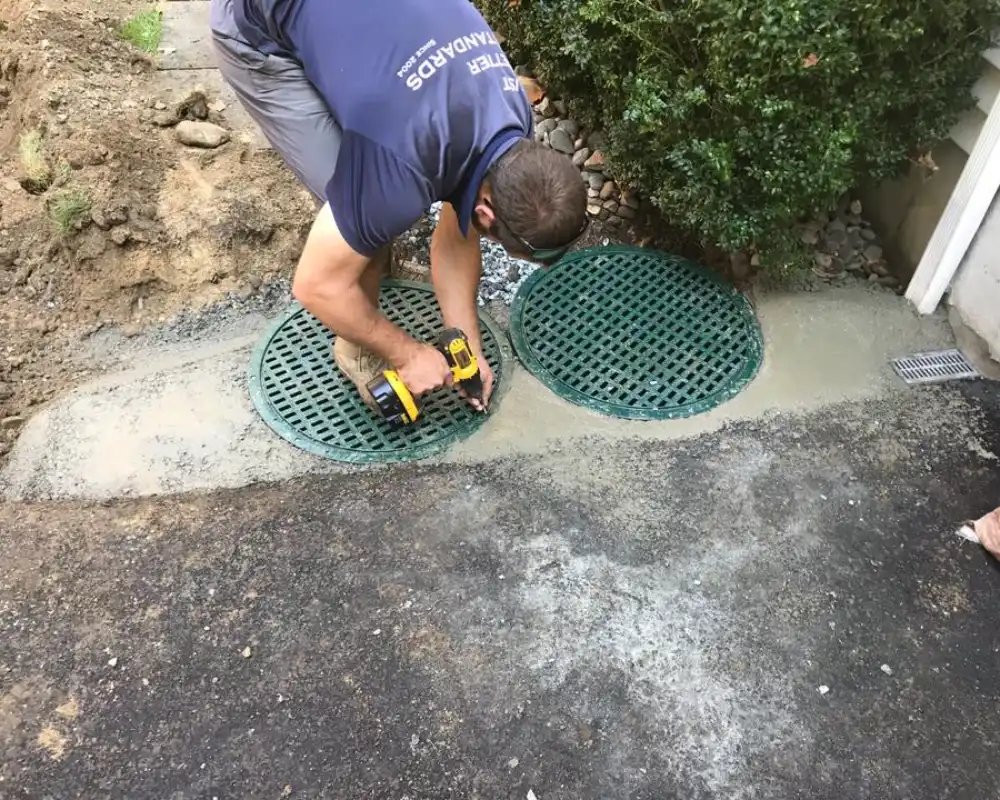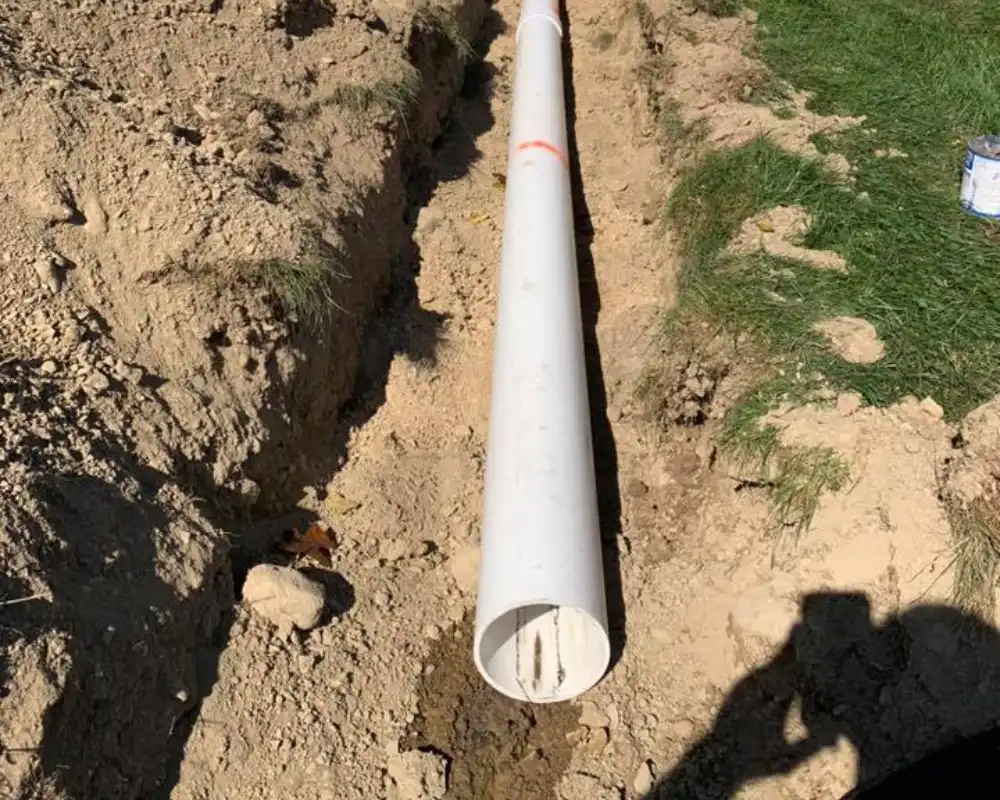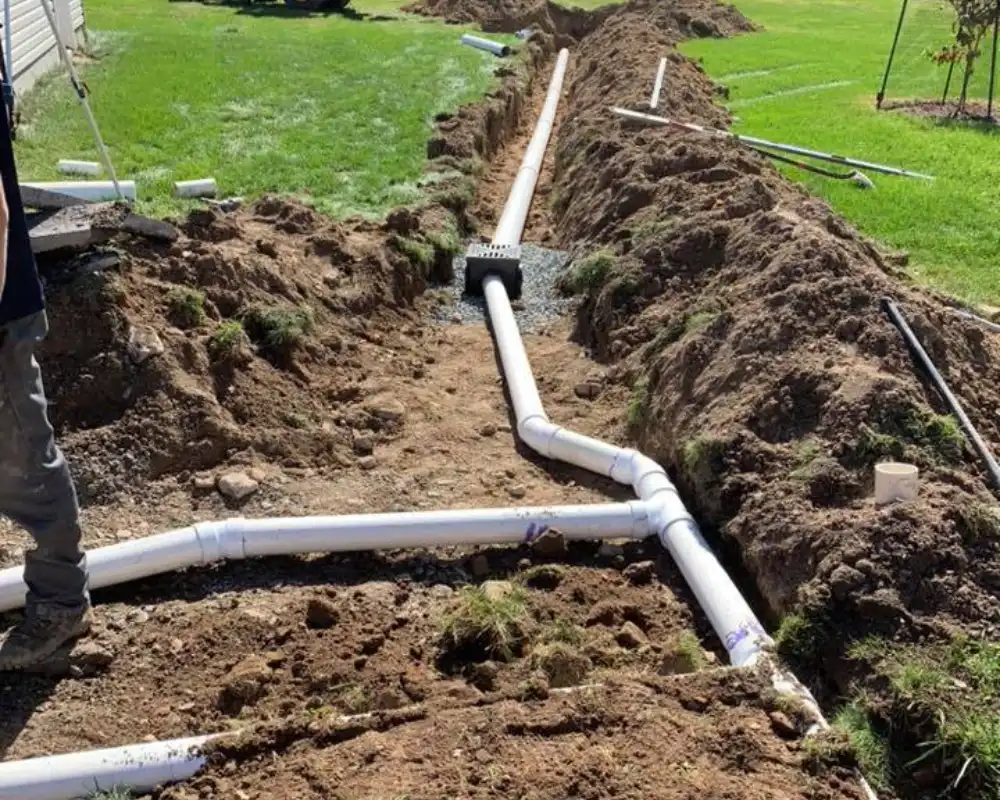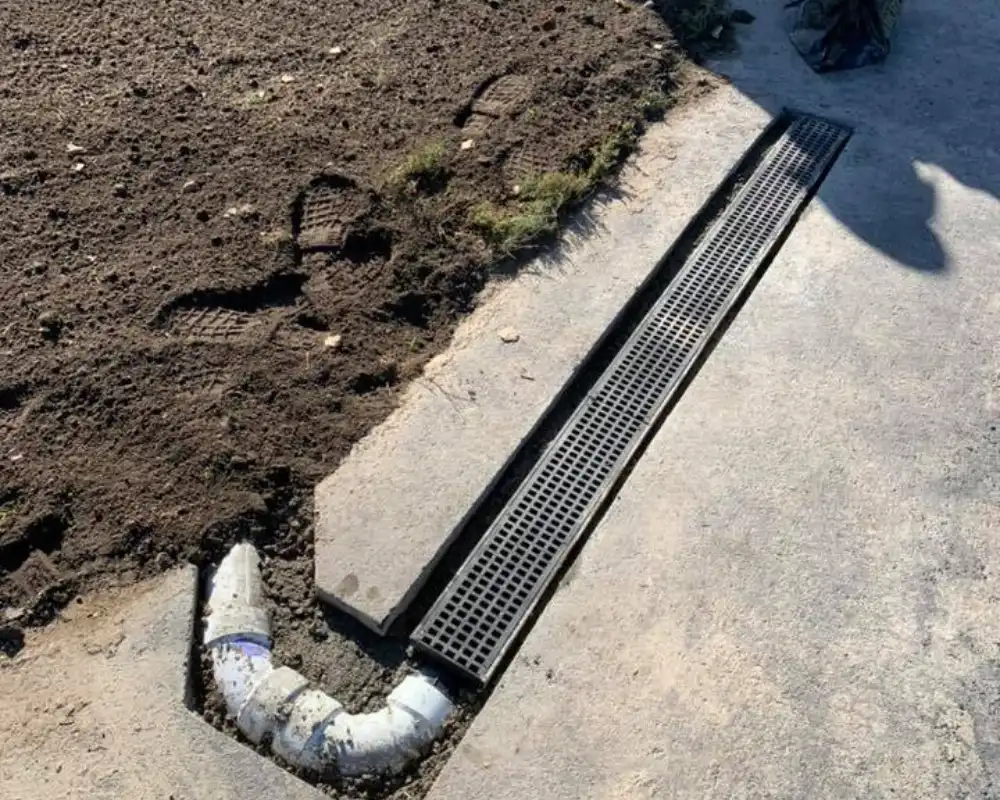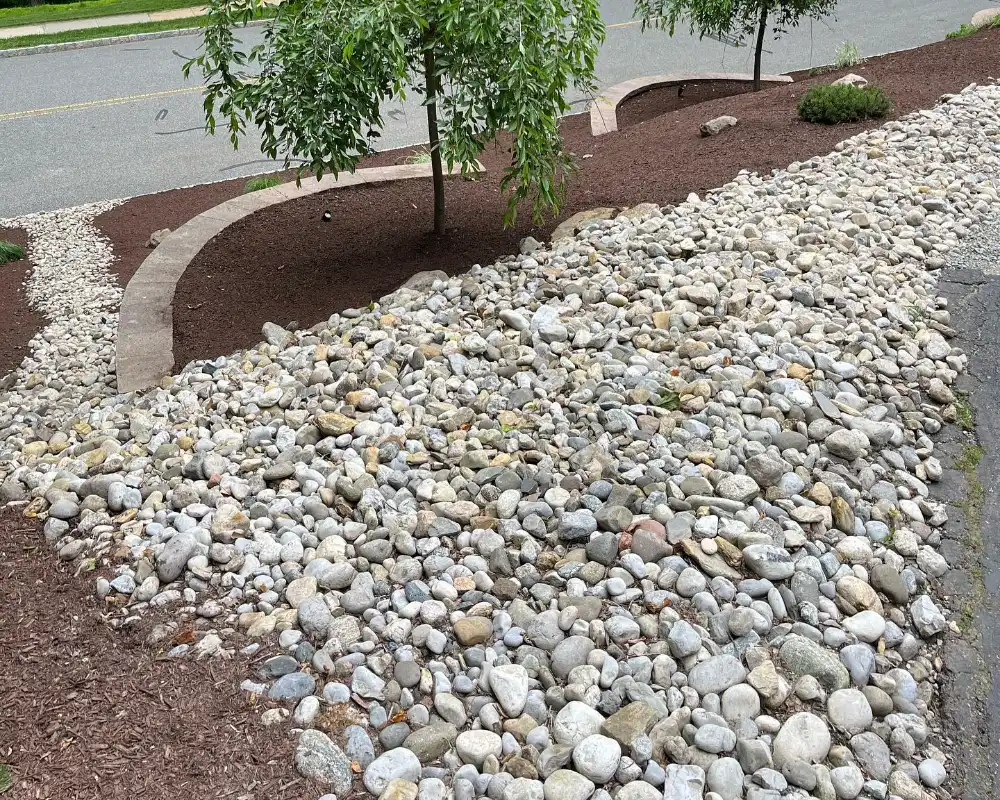Landscape Drainage
Creative Drainage Solutions For Your Landscape
We Can Fix Pooling Water On Your Lawn Or Landscape
Proper drainage is one of the most critical—and often overlooked—factors in maintaining a healthy, long-lasting landscape. In New Jersey, where we receive an average of 45+ inches of rainfall annually, poor drainage can quickly lead to serious problems like soil erosion, standing water, foundation damage, and flooding in basements or crawl spaces.
Here in Warren and Morris Counties, many properties are built on glacial till soils, which can range from heavy, slow-draining clay to loose, sandy material that erodes easily. While clay soils tend to hold water and contribute to pooling and saturation, sandy soils are highly susceptible to erosion. This is especially noticable during heavy rains. Without a well-designed drainage system in place, your lawn, garden beds, hardscaping, and even your home’s structure can be put at risk.
At JB’s Landscaping, we specialize in diagnosing and solving residential drainage issues specific to New Jersey’s soil types and weather patterns. Whether you need a French drain, drainage swale, dry creek bed, rain garden, or strategic property grading, we’ll design a solution that protects your investment and keeps your landscape looking its best.
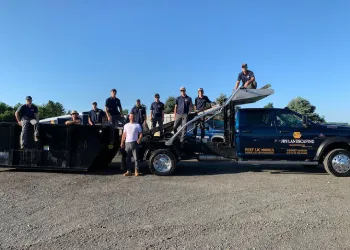 JB’s Landscaping is a premier landscaping company based in Columbia, New Jersey, proudly serving homeowners in Warren and Morris Counties.
JB’s Landscaping is a premier landscaping company based in Columbia, New Jersey, proudly serving homeowners in Warren and Morris Counties.
We specialize in designing and installing creative, functional, landscape drainage systems including drainage swales, French drains, dry creek beds, and more.
We offer real drainage solutions for properties with a constant drainage or standing water problem.
What Type Of Drainage Problem Do You Have?
- Is there water pooling up on your property?
- Does your property have soil erosion due to heavy rain?
- Do you have soft spots in your lawns or gardens?
- Do you have standing water around your foundation?
- Is your driveway or parking area a wet mess when it rains?
Without proper drainage in place your landscaping and lawn areas can be prone to flooding, it can drown out your expensive plants, erode away expensive hardscaping, and even cause damage to your structures and their foundations.
Many of our clients properties suffer from poor drainage or have drainage systems that just weren’t implemented correctly from the start which has led to significant erosion problems, water pooling, soft spots, and flooding in their lawns, gardens and landscapes. We can help solve these problems by developing a solid drainage plan for your property.
Smart Drainage Solutions Designed to Protect & Perform
Prevent erosion, flooding, and property damage
Drainage Solutions We Provide
We incorporate expert drainage solutions in every landscape we design and build. We can incorporate proper drainage systems into an already existing landscape.
French Drains
What Is A French Drain?
A French drain might sound intricate, but it's actually a simple yet effective solution for many homeowners facing drainage issues. Essentially, a French drain is a slightly sloped trench filled with gravel or rock, containing a perforated pipe that redirects surface water and groundwater away from specific areas. It's an ingeniously simple concept that has been used for centuries to combat excess water.
Functionality of a French Drain
The core idea behind a French drain is its ability to capture and divert water. When water enters the trench, it quickly seeps through the gravel and into the perforated pipe. This pipe then channels the water away from your property, often to a more suitable drainage area like a street, a ditch, drainage swale, or a storm drain.
Common French Drain Applications Around Residential Properties
Preventing Water Accumulation Around Foundations: One of the most popular uses of a French drain is to prevent water from pooling around a house's foundation. Water near the foundation can lead to serious issues like structural damage or basement flooding. By installing a French drain, this water is efficiently rerouted, safeguarding your home's integrity.
Managing Water in Soggy Yards: For yards that tend to get soggy or have standing water after rain, a French drain can be a game-changer. It helps in quickly moving the water away, keeping your yard dry and usable.
Facilitating Drainage in Hardscaped Areas: In areas where hardscaping like patios or walkways prevents natural absorption of water, French drains can provide an alternative path for water, preventing pooling and potential damage or slipping hazards.
Garden and Landscape Protection: Gardens and landscaped areas can suffer from too much water. A strategically placed French drain can help regulate the moisture level in these areas, ensuring that plants don't get waterlogged.
Resolving Slope-Related Drainage Issues: If your property is on a slope, managing runoff can be challenging. French drains can be part of a comprehensive solution to control and direct the flow of water, preventing erosion and landscape damage.
Drainage Swales
What Is A Drainage Swale?
A drainage swale is a shallow channel or depression that is designed to carry and manage stormwater runoff. It is typically found in landscaped areas, such as along the side of a road or where a culvert outflow is located. Swales are used to intercept and convey excess water from storms or other sources to a drainage outlet, such as a storm drain or a natural waterway.
Drainage swales are often used as an alternative to traditional stormwater management systems, such as underground pipes, because they can be more visually appealing and have a variety of additional benefits, such as providing habitat for wildlife and helping to reduce erosion. Drainage swales are typically lined with river rock or with vegetation, such as grasses or native plants, which helps to filter pollutants and sediment from the water as it flows through the channel.
Understanding the Swale's Function
The primary purpose of a drainage swale is to control water flow. During heavy rains or snow melts, water can accumulate and move rapidly, causing erosion and potential damage to your landscape. A swale acts as a natural conduit, controlling the speed and direction of water flow. It's a subtle yet effective way to manage excess water without the need for complex plumbing or electrical systems.
Common Applications Around Residential Properties
Preventing Water Accumulation: Swales are particularly useful in preventing water from pooling in low-lying areas of your yard. By directing water away, they help in maintaining a drier, healthier lawn and garden.
Safeguarding Foundations: Much like French drains, swales can be used to divert water away from your home's foundation, protecting it from potential water damage.
Landscaping and Garden Protection: Strategically placed swales can enhance the drainage around gardens and landscaped areas, ensuring that plants are not overwhelmed by excess water.
Enhancing Aesthetic Appeal: While primarily functional, swales can also be integrated into your landscape design. With the addition of grass or other vegetation, they can add a natural, visually appealing element to your yard.
Erosion Control on Sloped Properties: For properties situated on a slope, swales can be crucial in minimizing soil erosion. By slowing down the speed of water runoff, they help in preserving the integrity of your landscape.
Eco-Friendly Water Management: Swales are an environmentally friendly solution for water management. They can facilitate the replenishment of groundwater and reduce the burden on stormwater systems.
A Natural Solution for Your Landscape
Drainage swales represent a harmony between functionality and nature. They provide a cost-effective, low-maintenance solution to several common drainage problems faced by homeowners. By incorporating a drainage swale into your landscape, you can protect your property from water damage in an eco-friendly and aesthetically pleasing manner.
Dry Creek Beds
What is a Dry Creek Bed?
In the world of landscaping and drainage solutions, a dry creek bed stands out as a blend of functionality and natural beauty. A dry creek bed is essentially a man-made channel or gully, often lined with stones and rocks, designed to mimic the look of a natural dry stream. The key purpose of this feature is to provide an effective and aesthetic way to manage and direct the flow of water across your property.
The Aesthetic and Functional Blend
A dry creek bed is more than just a practical drainage solution; it's a landscaping feature that can significantly enhance the visual appeal of your outdoor space. Carefully selected stones and thoughtful placement create a natural-looking waterway that blends seamlessly with your garden and yard.
Common Applications Around Residential Properties
Erosion Control: For properties with sloped terrain where water runoff causes erosion, a dry creek bed can be a savior. It channels the water flow, reducing erosion and preserving the integrity of your landscape.
Rainwater Diversion: During heavy rainfall, dry creek beds effectively divert excess rainwater away from sensitive areas like foundations, gardens, or lawns, directing it to a more appropriate drainage area.
Addressing Soggy Areas: In yards where water tends to collect and create soggy patches, a dry creek bed can provide an escape route for this water, keeping your yard drier and healthier.
Aesthetic Enhancement: Beyond its functional role, a dry creek bed can be a striking landscape feature, adding a unique and natural charm to your outdoor space. It can be a focal point or a subtle addition, depending on your preference.
Wildlife Attraction: Interestingly, dry creek beds can attract wildlife, providing a habitat for birds and beneficial insects. The varying sizes of rocks and the layout can create microhabitats that are appealing to small wildlife.
Integrating with Your Landscape
The beauty of a dry creek bed lies in its versatility and adaptability. It can be designed to suit any landscape style, from a rustic, woodland look to a more modern, minimalist approach. With the right design and placement, a dry creek bed not only solves drainage issues but also elevates the overall aesthetics of your property.
A Sustainable Approach to Drainage
Embracing the concept of a dry creek bed is not just about solving water runoff issues; it's about doing it in a way that respects and enhances the natural environment. This eco-friendly solution is a testament to how functional landscaping can be both effective and beautiful.
Drainage Solutions Can Also Include
There is no one-size-fits-all drainage solution for every single property. Often, it takes a few different solutions working together to solve your drainage problems.
Drainage System Repairs: Maintenance and repair services for existing drainage systems, including clearing blockages, fixing leaks, and ensuring optimal functionality.
Drain Box and Catch Basin Installation: Placement of catch basins and drain boxes at low points to collect surface water, effectively preventing pooling and directing water into drainage systems.
Downspout Drainage Systems: Integration of downspouts with the landscape drainage system to efficiently channel roof runoff away from the building foundation, reducing soil erosion and water damage.
Drainage Problem Correction: Diagnostic and corrective measures to address and resolve issues with existing drainage systems, ensuring they effectively manage water runoff and protect landscape integrity.
Grated Trench Drains: Installation of linear drains with grates, ideal for capturing runoff on hard surfaces like driveways and sidewalks, and directing it to safer discharge areas.
Rain Garden Construction: Design and creation of rain gardens that use native plants and soil amendments to capture, filter, and slowly absorb rainwater, reducing runoff and improving water quality.
Permeable Paving Solutions: Implementation of permeable paving materials that allow water to percolate through the surface, reducing runoff and recharging groundwater.
Roof Runoff Management Systems: Systems designed to capture, store, and repurpose rainwater from roofs, incorporating rain barrels or cisterns for landscape irrigation or other uses.
Erosion Control Measures: Strategies and installations like vegetation, mulches, and terracing to prevent soil erosion by stabilizing areas prone to runoff damage.
Retaining Wall Systems with Built-in Drainage: Construction of retaining walls that incorporate drainage features to manage water pressure and prevent moisture buildup behind the wall.
Channel Drains: Shallow channels that capture surface water over larger areas, such as pool decks and patios, efficiently directing it to drainage outlets.
Bio-retention Cells: Engineered systems that use vegetation and soil to capture and treat stormwater onsite, promoting infiltration and reducing pollutants.
Our Clients Love Us!
Here's What They Say
Excellent experience with Jeff and his crew to replace front sidewalk. Will definitely call JB"s again
We have been so lucky to have JBs take care of our seasonal landscaping/hardscaping needs and also snow plowing/salting for both our family home and our business properties. They have been reliable and reasonable over the years. Jeff has gone out of his way to accommodate our requests and Angela is a pleasure to work with.
We have been customers since 2012! Every year we start off the season with a Spring Clean up in our gardens and lawn followed by a lawn fertilization. Then our weekly lawn cuttings go from mid April to late October early November. The maintenance team does a thorough job leaving our lawn looking neat and nicely manicured. The office staff is attentive and makes sure to satisfy our special requests. Kudos to JB’s, you will look forward to seeing their truck pull up to your property every week! LO (Blairstown)

